Introduction

Aging is a natural process that everyone will experience. As we grow old, changes in our body composition happen and several physiologic functions decline including the ability to break down and synthesize protein. Hence, with aging comes a decline in muscle mass and function. As a result of this, we tend to lose our strength and power. This condition is called sarcopenia, which could limit our ability to function well, thereby affecting the quality of our lives. While we can’t stop time to remain young, we can age gracefully and healthily. Read on to learn how you can flex your muscles even in your golden years!
What is sarcopenia?
Aging causes a progressive degeneration of our body’s muscle mass. The size and the number of skeletal muscle fibers decline as we age. The loss of muscle mass causes a decline in our muscle strength and function. This age-related, involuntary loss of skeletal muscle mass and strength is called sarcopenia.1
We may not notice it, but loss of muscle mass happens earlier than we think. It may set in around the age of 35 with 1-2% rate of decline per year. Beyond age 30, muscle loss accelerates up to 3% per year.2
It is not always obvious to see our muscles being lost because the scale may tell otherwise. This means that our muscles are wasted while it is being replaced by fat, hence we maintain or increase our weight despite experiencing sarcopenic obesity.3 Further, not only do we become weaker, but we also become slower as the type II or fast-twitch muscle fibers are lost at a greater rate than the type I or slow-twitch muscle fibers.
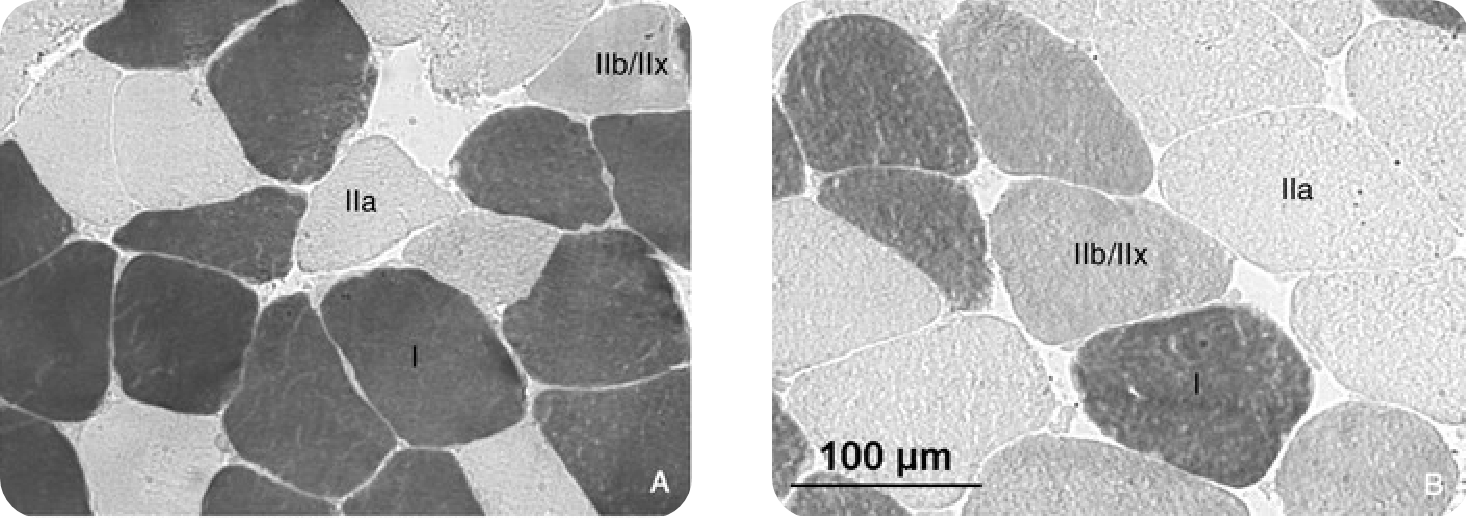
Figure 1. Muscle fiber type analyses performed on muscle tissue collected from elderly (A) and young (B) males by ATPase staining of muscle cross sections; type I fibers are black, and type II fibers are white (IIa) or show intermediate staining (IIb/IIx). Type II fibers are significantly smaller in the elderly vs. the young. [Image and Description Source: Verdijk et al. (2007)
What really causes sarcopenia or age-related muscle loss?
Sarcopenia, in general, is a multifactorial process. It can be caused by reduced endocrine function, physical inactivity and inadequate nutrition.5 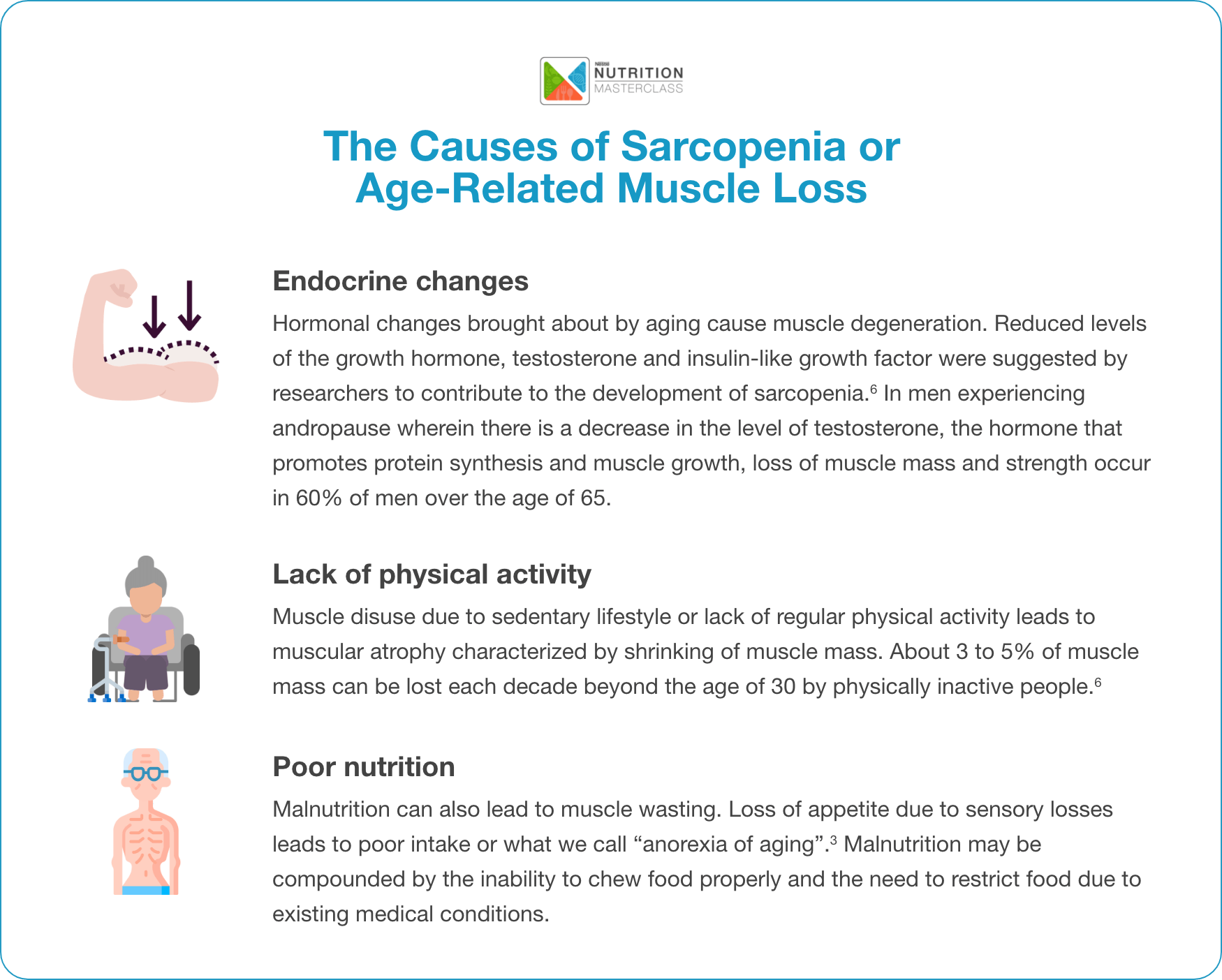
Does sarcopenia affect one’s quality of life?
When a person experiences sarcopenia, weak muscles slow our movement, restrict our independence, and make it hard for us to do our daily tasks such as walking, cleaning the house, going to the market and even outdoor activities with our peers, relatives, and friends. What’s more, reduced lean muscle mass poses higher risk of infection and lowers the rate of recovery from illness. It also affects one’s ability to balance properly when in motion or when standing still. No wonder, many older adults are prone to falls, which sometimes lead to alarming consequences. While incidence of falls among elderly may be attributed to other causes, such as unsafe environment and history of falls7, muscle weakness and inability to balance compounds the risk.
Is there a way to delay the onset and slow the rate of sarcopenia?
While muscle degeneration is a natural phenomenon that everyone will experience, the rate of muscle mass decline can be slowed, and the onset can be delayed. Early changes to lifestyle habits and good nutrition play a crucial role in the preservation of muscle mass and its strength. Now here’s to aging gracefully! 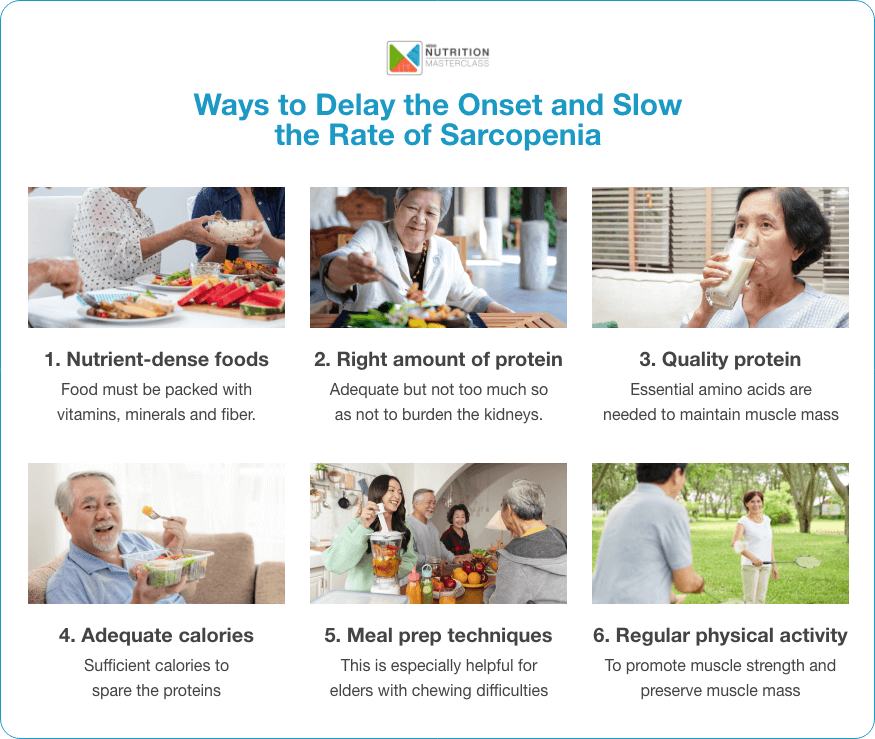
HOW MUCH PROTEIN DOES YOUR BODY NEED EVERY DAY?
As you age, you start losing muscle mass because your body becomes less efficient in storing protein. Take the test to determine how much protein you need to consume everyday.
- Consumption of quality protein sources
The type and quality of protein in the diet is equally important as the amount. Intakes of high biological value proteins with complete essential amino acids help prevent muscle wasting and promote synthesis of lean body mass. Good sources of high biological value protein are meat, fish, poultry, eggs, and dairy products. These food items are best coupled with other foods rich in healthy protein from plant sources such as peas, beans, nuts, lentils, cereals (rice, oats, barley, rye, millet, sorghum) and cereal products (bread, pasta), seeds, and gelatin. Read more about protein and its sources.
- Intake of adequate calories
Along with adequate protein intake, one must ensure sufficient caloric intake to spare protein’s action for the synthesis and preservation of muscle mass. A typical older adult aged 50-59 needs about 2,420 and 1,870 kcal for male and female, respectively. Generally, daily caloric requirements will be decreasing from then on as Filipinos aged 60-69 have a daily caloric requirements of 2,140 and 1,610 kcal for male and female, while those aged over 70 have caloric requirements of 1,960 and 1,540 kcal, respectively.9
- Small improvements in meal preparation
This may mean changing the consistency of meals, preparation techniques, and choosing softer cuts or types of meat such as fish and chicken can improve tolerance and the amount of protein intake. This is especially helpful among elderly who are having trouble with their oral functioning. Adding a hint of natural spices to lentils and lean meat improves taste and can stimulate salivary secretion, which will aid in mastication and swallowing.
- Regular physical activity
Regular physical activity and structured exercises that promote strength or resistance and power contribute to stronger muscles!
According to Harvard Medical School, a well-rounded strength training program should involve key muscles such as shoulders and arms, back, front of torso, hips, buttocks, and legs.2 Outlined below are sample exercises that an old person can do to strengthen and preserve muscle mass.
Suggested Workouts and Exercises
| Strength and Power Workout I for beginners | Strength and Power Workout II for regular exercisers | Balancing and Stretching Exercises |
|---|---|---|
| Standing calf raise | Forward fly | Calf stretch |
| Chair stand | Overhead press | Thigh stretch |
| Stair climbing | Triceps extension | Hamstring stretch |
| Hip extension | Double biceps curl | Double hip rotation |
| Seated bridge | Dumbbell squat | Hip flexors stretch |
| Biceps curl | Side leg raise | Side stretch |
| Triceps dip | Bridge | Shoulder rotation |
| Curl up* | Advanced curl up* | Hip and lower back stretch |
| Standing side bridge | Side bridge | Inner leg stretch |
| Back extension | Triceps stretch |
*If you have osteoporosis or other health conditions, talk to your doctor before trying this exercise. He or she may recommend that you avoid it.
But before you commit yourself to these exercise programs, you need to consider your safety first. You may ask your doctor about any health conditions that may be adversely affected by strength or power training or other types of exercise. You can also ask for certain medications, which may affect your exercise performance or vice versa, and your limits as to the type of intensity, duration, and frequency of exercise.
Ways forward

We must embrace the fact that as we age, our body ages, too. But this doesn’t necessarily mean that we no longer have the chance to live a quality life. Aging is an opportunity for us to commit to ourselves to living healthy as we celebrate our birthdays yearly. Eating healthy meals regularly, improving protein intake from animal and vegetable sources, and staying active through regular exercise are our key to a healthy aging!
Message to RNDs
As practicing RNDs, let us highlight the importance of adequate protein and calorie intake coupled with regular physical activity among our adults and elderly clients/patients. It is also important to look into nutrition-focused physical manifestations of muscle wasting to provide prompt nutrition intervention and prevent further muscle losses.
Pro Tip
Consume adequate calories, keep protein to a minimum of 0.8g/kg/body weight, and exercise regularly by injecting strength or resistance exercises to prevent and delay muscle losses brought about by aging!


 Aiza Kris M. Bernardo , RND
Aiza Kris M. Bernardo , RND









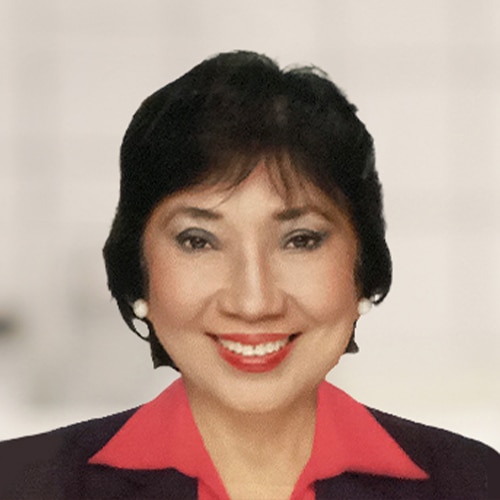
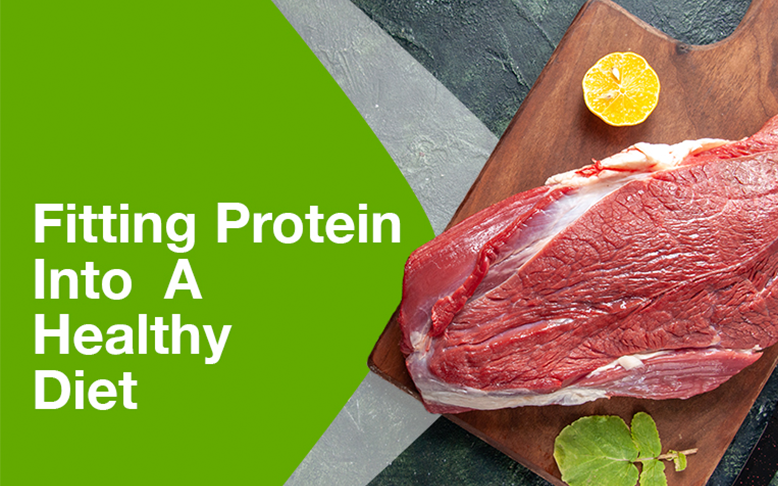




No comments here yet.